What is it benign family pemphigus?
Benign familial pemphigus is also known as Hailey-Hailey disease. It's a weird hereditary Blistering skin disease first described by the Hailey brothers in 1939.
Who gets benign family pemphigus?
Benign family pemphigus usually appears in the third or fourth decade, although it can occur at any age. Then it tends to persist throughout life. It can affect people of all races.
What is the cause of benign family pemphigus?
Benign familial pemphigus is an inherited skin disorder, although sporadic cases with no family history occasionally arise. The responsible defect has now been identified in a gene called ATP2C1 found in chromosome 3q21-24. This gene codes for the SPCA1 protein (calcium / manganese-ATPase secretory pathway), a calcium and manganese pump. Skin cells (keratinocytes) are held together through structures called desmosomes and it seems that desmosomes don't assemble properly if there isn't enough calcium.
the genetic The benign familial pemphigus defect causes the skin cells to detach from each other. Cells are typically packed together in much the same way as bricks and mortar. Patients with Hailey-Hailey disease have a defective "mortar" and the cells are crumbling, like a ruined brick wall.
What are the clinical characteristics of benign pemphigus?
Benign family pemphigus usually begins as a symmetrical painful erosive and crusted skin eruption in skin folds Common sites include the armpits, groin, and neck, under the breasts, and between the buttocks. The injuries tend to come and go and leave no scars. As the lesions grow, the center clears and leaves a typical ring shape. If the lesions are present for some time, they can thicken. The skin tends to macerate, leaving quite painful cracks.
Heat, sweating, and friction often. exacerbate the disease, and most patients have worse symptoms during the summer months.
Rarely, benign family pemphigus can be unilateral or have a linear arrangement, or may involve mucous membranes White bands may also appear on the nails and pits on the palms.
Benign family pemphigus
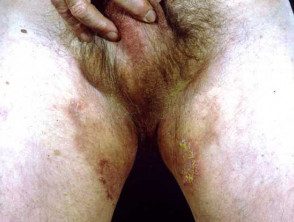
Hailey-Hailey disease

Hailey-Hailey disease blisters
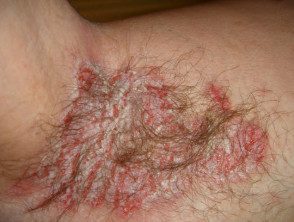
Hailey disease Hailey in armpit
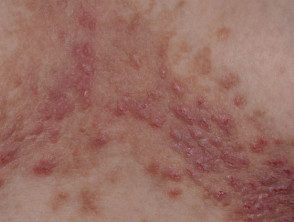
Hailey Hailey chest disease
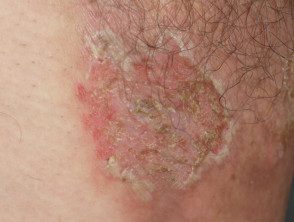
Hailey Hailey in the groin
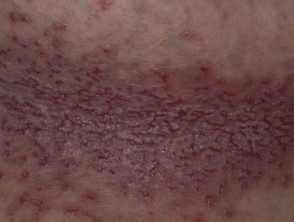
Hailey disease Hailey close
What are the complications of benign family pemphigus?
For many patients, benign familial pemphigus is a mild condition, but for others, Pain and odor can be serious problems. Secondary bacterial infection, which is not uncommon, can lead to an unpleasant odor. Herpes simplex can infect blistered sites and can progress to extendedpainful viral infection (eczema herpetic).
How is benign familial pemphigus diagnosed?
Benign pemphigus is usually diagnosed by its appearance and family history, but is often mistaken for other skin problems. Impetigo, thrush, ringworm (jock itch) and other blistering conditions are similar.
Diagnosis may require skin biopsy. the histology it is characteristic, with layers of detached skin cells ('acantholysis') Lining up like' a row of headstones'. Unlike pemphigus vulgaris, the immunofluorescence do a test for antibodies it's negative
As of yet there are no diagnostic tests available for family members.
How is benign familial pemphigus treated?
There is no cure for Hailey-Hailey disease. Treatment is aimed at reducing symptoms and preventing flare-ups.
General advice
- Avoid triggers like sunburn, sweating, and friction when possible; When it's hot, stay indoors with a fan or air conditioner, and limit the amount of exercise done.
- Gently wash and dry skin folds once or twice a day with mild soap and water.
- Wear soft, loose-fitting clothing with absorbent pads on underwear.
- If you are overweight, try lowering body fat to minimize friction.
- Apply wet compresses, such as 1:40 diluted aluminum acetate or vinegar, to dry oozing patches.
- Take bleach baths twice a week to reduce superficial infections.
- Apply zinc paste to inflamed patches.
- Use antiperspirants like roll-on and cream forms of aluminum salts and powder dust containing the anticholinergic drug diphemanil 2%.
Current recipes
-
Corticosteroid (cortisone) creams used short-term (eg, one to two weeks) are effective in treating inflamed lesions; They work best if they start early.
- Topical antibiotics like clindamycin or mupirocin are used short-term to located infection, but it is better to avoid it in the long term due to the risk of inducing bacterial resistance, for example, MRSA.
- The short-term use of combination corticosteroid / antibiotic creams may also be helpful.
-
Benzoyl peroxide is a useful antiseptic available as a cream or wash.
-
Ketoconazole cream can be used in case of fungal infection.
-
Calcipotriol cream is useful for some patients.
-
Fluorouracil cream has been reported to be effective in at least one patient.
- Topical calcineurin inhibitors such as pimecrolimus cream or tacrolimus ointment They have been reported to reduce the need for topical steroids.
Oral recipes
- Long courses of oral antibiotics, such as tetracycline, may be helpful.
- If the herpes virus infection is a recurrent problem, oral antivirals such as acyclovir are prescribed.
- Anticholinergic medications such as glycopyrrolate may be prescribed to reduce hyperhidrosis (excessive sweating).
- A number of other oral medications (retinoids, cyclosporine, dapsone, and methotrexate) have been reported in single cases as partially effective, but no large trials have been conducted.
Other treatments
-
Corticosteroid injections in inflamed plates
-
Botulinum toxin to reduce sweating in armpits and English, thus reducing colonization by microorganisms and shoots
-
Phototherapy (ultraviolet light) has also been used.
- Photodynamic The therapy has had varying success.
-
Lasers have been reported to be useful in one study, eg CO2To be o Er: YAG laser vaporizing the affected skin, or pulsed dye laser that improves wound healing.
- In severe cases, surgery can be done to remove the affected skin. Skin grafts are generally necessary to repair wounds.
-
Dermabrasion has been reported to give excellent long-term results.
-
Afamelanotide implants eliminated Hailey-Hailey disease in 2 patients. [1]
- Several patients have been reported to improve Hailey-Hailey disease when treated with low-dose naltrexone. [2]
Will benign family pemphigus improve over time?
Many patients have a long time referrals and there is an improvement with age.
